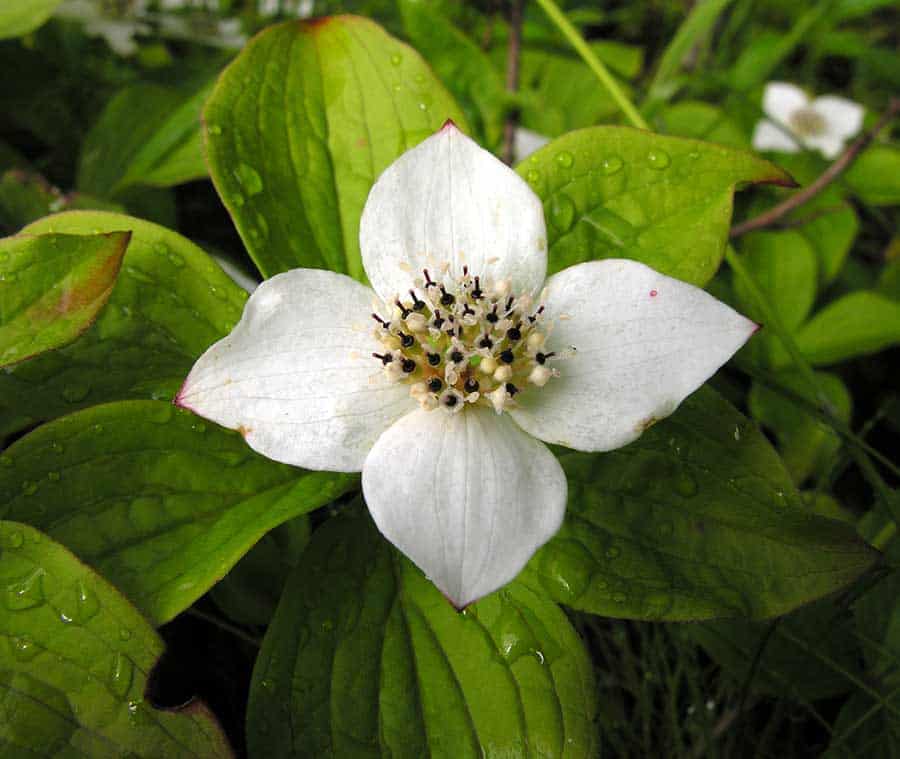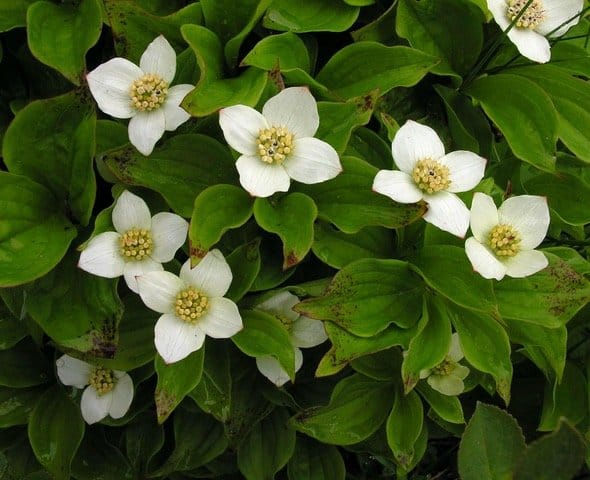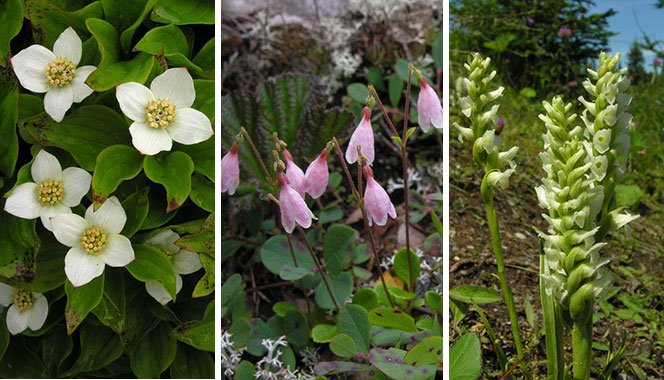
In a nation-wide poll that ended on Canada Day, 80% of almost 10,000 people picked bunchberry (Cornus canadensis) as their choice for a national flower. The flower is known as quatre-temps in French and kawiscowimin in Cree. From the beginning of the National Flower Contest in March, the little white flower held the lead in the online vote, says Maureen Hulbert, executive director, Toronto Master Gardeners, who spearheaded the contest by the Master Gardeners of Ontario.
Bunchberry, along with hooded lady’s tresses (Spiranthes romanzoffiana) and twinflower (Linnaea borealis), were identified as three finalists with the help of Todd Boland, research horticulturist with Memorial University of Newfoundland in St. John’s, because they are found all across the nation, growing wild in most areas, and are not already designated as provincial or territorial emblems.
Bunchberry changes with the seasons, just like Canada does, says Hulbert, with white flowers in late spring, red berries in summer, and red leaf colour in fall.
One of the smallest members of the dogwood (Cornus) family, bunchberry forms a low, carpet-like mat of leaves, up to four inches (10 cm) tall; you’ll typically see it in the understorey of moist, shady woods. In late spring, it produces showy “flowers” that appear a few inches above the leaves. These white flowers are modified leaves called bracts, which attract pollinators to the actual flowers in the centre.
Bunchberry is largely self-sterile, which means it is dependent on pollinators, such as bumblebees, solitary bees, bee flies and syrphid flies, for reproduction.
Once pollinated, it produces edible fruit, a food source for black bears, martens, snowshoe hares and other small mammals, as well as many migratory birds. Bunchberry is also a winter forage plant for caribou, elk, deer and moose.
The Master Gardeners will submit an online petition to Parliament to have the winner declared Canada’s official national flower.
“We all love to celebrate the wildness of Canada and its varied areas and having something that can actually grow in every part of the country pulls us together,” Hulbert says. “The generic maple is considered Canada’s national tree. But of the 150 or so types of maple in the world, only 13 are native to North America, of which 10 grow in Canada, and not all grow in every province and territory.”
Of course, Canada’s provinces and territories have deep-rooted floral emblems to represent regional distinctions, ranging from Nova Scotia’s mayflower, designated in 1901 and said to be named after the namesake ship that took British pilgrims to the New World, to Nunavut’s purple saxifrage, designated in 2000, which grows like a carpet over the territory’s rocky surfaces.
Around the world, Scotland’s national flower is the thistle. Wales has designated the daffodil (the vegetable leek is also considered to be a national emblem). The U.S. Senate passed a resolution in 1985 to declare the rose its national floral emblem. Australia has deemed the golden wattle (Acacia pycnantha) to reflect its cultural identity.

The 3 choices presented

Hooded lady’s tresses (Spiranthes romanzoffiana)
There are about 65 species of orchids native to Canada in different areas across the country — some of the most spectacular plants found in the wild. Hooded lady’s tresses is a stunning, unique-looking orchid found in bogs, marshes and damp meadows; its spiralling flower spikes of usually white flowers grow up to 30 inches (50 cm) tall.
This native has a light, almond scent and provides a food source for native bumblebees throughout the summer, flowering from July to September.
Twinflower (Linnaea borealis)
Twinflower is a very adaptable evergreen perennial, found in every type of Canadian habitat — forest, wetland, meadow and tundra. It is inconspicuous except for a week or so in June or July, when it produces lovely pale-pink pairs of flowers — hence the common name — on six-inch (15-cm), Y-shaped stems. Its flowers are highly fragrant, providing a food source to native bees during its short period of bloom. The plant forms a dense evergreen mat that is used as winter forage by caribou.
The name Linnaea comes from Carl Linnaeus, the father of modern taxonomy, given the plant grows commonly in his native Sweden. Borealis refers to its northern distribution. “We Canadians like to consider ourselves of northern heritage,” says Maureen Hulbert. “Some have also suggested that the two flowers per stem give a nod to our bilingual nature as a country.”

I am pleased with the choice of the bunchberry because it grows all over Canada.
As a national flower it does not have to be one that is grown in gardens given that the majority of Canada’s landmass is not domestic!
As someone who has lived in most provinces and visited the rest (including the territories) I have seen the bunchberry growing across the country. I think as a national flower it needs to go beyond ones that are limited to a province or two, the need for flowers that grow locally is already met by the various provincial flowers.
Where can I purchase Bunchberry, I live in Waterloo On and love these plants.
Where do you click to vote? I have gone to the site – highlighted my vote.
Clicked in front – clicked behind
Tried most everything ….. Help
This is my vote if this can be passed on:
1. Hooded lady’s tresses (Spiranthes romanzoffiana)
This was a hard decision but I gave my nod to the twinflower.
My vote is for the white ‘Twinflower.’